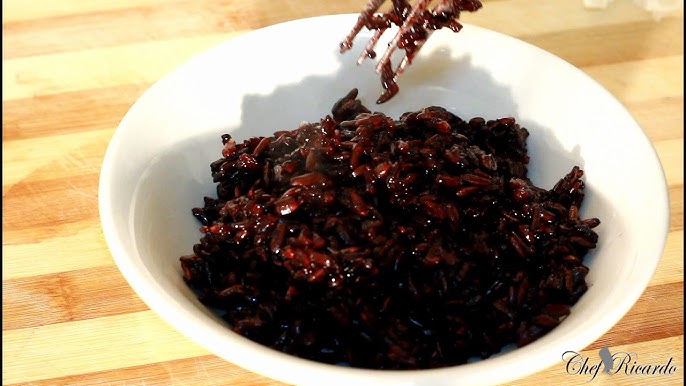Black Rice Recipe: Black rice, often referred to as “forbidden rice,” is an ancient grain that was once reserved for Chinese royalty due to its rich nutritional value. It has a deep purple-black hue, which comes from a powerful antioxidant called anthocyanin—the same compound found in blueberries and blackberries. This rice is slightly nutty in flavor, with a chewy texture, and it’s widely loved for both its taste and health benefits.
Unlike white rice, black rice retains its outer bran layer, which makes it a whole grain. That means you’re getting more fiber, protein, and vitamins in every bite. It’s a powerhouse grain that can elevate your meals, whether used in salads, bowls, or desserts.
Health Benefits of Black Rice
Here’s why adding black rice to your diet is a smart move:
- Rich in Antioxidants: Thanks to anthocyanins, black rice helps reduce inflammation and fight free radicals.
- High in Fiber: Keeps you fuller for longer and supports healthy digestion.
- Good Source of Plant-Based Protein: Ideal for vegetarians and vegans.
- Supports Heart Health: May help lower cholesterol and improve heart function.
- Gluten-Free: Naturally suitable for people with gluten sensitivities.
Incorporating black rice into your diet isn’t just about trying something exotic—it’s a nutritious choice that your body will thank you for.
Ingredients Needed for Black Rice Recipe
Basic Ingredients
Making black rice is surprisingly simple. Here’s what you’ll need for a basic recipe that serves about 2–3 people:
- 1 cup black rice
- 2 cups water
- 1/2 teaspoon salt (optional)
- 1 tablespoon olive oil or coconut oil (optional)
This minimalist approach brings out the natural, nutty flavor of black rice without overpowering it. If you prefer your rice soft and sticky, increase the water slightly during cooking.
Optional Add-Ons for Enhanced Flavor
You can easily jazz up your black rice recipe depending on what you’re serving it with. Here are some ideas:
- Minced garlic or onion for aroma
- Coconut milk for a creamy, dessert-style version
- Bay leaf or cinnamon stick for subtle flavor infusion
- Fresh herbs like cilantro or parsley for garnish
- Vegetables like bell pepper, carrot, or peas for color and crunch
The beauty of black rice is that it works well in both savory and sweet dishes. You can pair it with spicy stir-fries or turn it into a velvety pudding with coconut milk and sugar.
Preparing Black Rice Before Cooking
Soaking the Rice
Soaking black rice before cooking isn’t mandatory, but it significantly reduces cooking time and improves texture. Here’s how you do it:
- Measure out your rice and rinse it under cold water.
- Place it in a bowl with double the amount of water.
- Let it soak for at least 1 hour or overnight for best results.
Soaking softens the grain, making it easier to cook evenly and digest. It’s especially helpful if you plan to make a larger batch for meal prepping.
Washing and Rinsing
Whether you soak or not, rinsing is non-negotiable. Black rice tends to release a deep purple color when washed, so don’t be alarmed. This is just the anthocyanins at work.
- Place the rice in a fine-mesh strainer or bowl.
- Rinse under cold running water, stirring with your fingers.
- Repeat 2–3 times until the water runs clearer.
This process removes excess starch and any impurities, ensuring a fluffier end result.
Cooking Black Rice – Step-by-Step Instructions
Method 1: Stovetop Cooking
This is the most common and traditional way to cook black rice. Here’s how to do it:
- Combine 1 cup of rinsed black rice and 2 cups of water in a saucepan.
- Add salt and oil if using.
- Bring to a boil over medium-high heat.
- Once boiling, reduce the heat to low and cover the pan.
- Simmer for 30–35 minutes.
- Check for doneness—rice should be tender but slightly chewy.
- Turn off the heat and let it sit covered for 5–10 minutes.
- Fluff with a fork and serve warm.
Keep an eye on the water level. If it looks dry but the rice isn’t cooked, add a few tablespoons of water and continue simmering.
Method 2: Rice Cooker Method
Using a rice cooker makes things even easier:
- Add 1 cup rinsed black rice and 2 cups of water to the rice cooker.
- Add salt and oil if desired.
- Set your rice cooker to the ‘brown rice’ or ‘whole grain’ setting.
- Let it cook automatically—no need to stir or watch.
- Once done, let it rest for 10 minutes before opening.
- Fluff and serve.
This method is great for busy days and guarantees even cooking every time.
Serving Suggestions and Variations
Savory Black Rice Dishes
Black rice can be transformed into a hearty, flavorful base for a variety of savory dishes. Its chewy texture and earthy taste complement bold seasonings and colorful vegetables. Here are a few creative ways to serve it:
- Black Rice Stir-Fry: Toss cooked black rice in a hot wok with garlic, ginger, soy sauce, and your favorite vegetables. Add tofu, shrimp, or chicken for a complete meal.
- Black Rice Buddha Bowl: Layer black rice in a bowl with roasted veggies, avocado slices, chickpeas, and a tahini drizzle for a nourishing lunch or dinner.
- Coconut Black Rice with Spicy Curry: Serve warm black rice alongside a spicy Thai or Indian curry. The subtle sweetness of coconut oil or coconut milk in the rice balances out the heat of the curry beautifully.
- Stuffed Bell Peppers: Use black rice as a filling for baked bell peppers along with tomatoes, onions, and melted cheese.
- Black Rice Sushi Rolls: Yes, you can use black rice for sushi! Just season it with rice vinegar, sugar, and salt after cooking and roll it up with your favorite sushi ingredients.
These savory applications highlight the rice’s versatility. It’s not just a side dish—it can be the star of your plate.
Sweet Black Rice Pudding
One of the most loved ways to enjoy black rice is in the form of dessert—specifically, a rich and creamy black rice pudding that’s popular in Southeast Asian cuisine. It’s simple, satisfying, and naturally sweetened.
Ingredients:
- 1 cup cooked black rice
- 1 ½ cups coconut milk
- ¼ cup palm sugar or brown sugar
- ½ teaspoon vanilla extract
- Pinch of salt
- Mango slices or banana (optional topping)
Instructions:
- In a saucepan, combine cooked black rice and coconut milk.
- Stir in sugar, vanilla, and salt.
- Bring to a gentle simmer over medium heat.
- Cook for about 15–20 minutes, stirring occasionally, until thick and creamy.
- Serve warm or chilled, topped with fresh fruit.
This pudding is naturally dairy-free and gluten-free. You can even make it vegan by using plant-based ingredients. It’s a decadent way to end a meal or to satisfy a midday sweet craving without the guilt.
Tips and Tricks for Perfect Black Rice
Timing and Texture
Getting the perfect texture with black rice can take a little practice, but once you get the hang of it, it becomes second nature. Here’s what to keep in mind:
- Don’t rush the process: Black rice is denser than white rice, so give it at least 30–35 minutes on the stovetop.
- Let it rest: After cooking, always let the rice sit with the lid on for 5–10 minutes. This helps the steam finish cooking the grains and gives a fluffier texture.
- Use the absorption method: Avoid draining the rice unless absolutely necessary. Measuring the water carefully allows the rice to absorb flavor and nutrients without wasting anything.
Remember, the goal is to achieve tender yet slightly chewy grains that hold their shape. Mushy black rice? Probably overcooked or over-watered. Dry and crunchy? Cooked too quickly or not enough water.
Flavor Boosters and Seasonings
While black rice is already packed with flavor, adding seasonings can take it to the next level. Here are a few ideas:
- Soy sauce, sesame oil, and scallions for an Asian twist.
- Garlic, rosemary, and olive oil for a Mediterranean feel.
- Curry powder, turmeric, and cumin if pairing with Indian dishes.
- Lime juice, cilantro, and avocado for a fresh, zesty profile.
You can also toast the rice in a dry pan for a few minutes before boiling—it adds a nutty aroma that really shines in savory dishes.
Storage and Meal Prep
Storing Cooked Black Rice
Black rice stores beautifully, making it ideal for meal prep. After cooking, let it cool completely before storing:
- Refrigerator: Store in an airtight container for up to 5–6 days.
- Freezer: Place in freezer-safe containers or zip-top bags. It will last up to 2 months.
When ready to eat, reheat it in a microwave with a splash of water or on the stovetop with a bit of oil or broth.
Meal Prep Ideas with Black Rice
Cook a big batch at the beginning of the week and use it in:
- Grain bowls for lunch.
- Stir-fried rice dinners.
- Breakfast porridge with fruit and nuts.
- Rice-stuffed wraps or burritos.
- Black rice salad with chickpeas, cucumber, and lemon vinaigrette.
It’s a nutritious base that holds up well to sauces and reheating, making your weekly meals both easy and exciting.
FAQs about Black Rice Recipe
1. Can I cook black rice without soaking it first?
Yes, but it will take longer to cook and may have a firmer texture. Soaking helps reduce cooking time and improve the grain’s texture.
2. Is black rice healthier than brown or white rice?
Absolutely. Black rice contains more antioxidants and fiber than both brown and white rice, making it the most nutritious option of the three.
3. Can I use black rice in sushi or rolls?
Yes! Just make sure to season it properly with vinegar, sugar, and salt like traditional sushi rice. It offers a unique visual and taste.
4. Why does the water turn purple when rinsing or cooking black rice?
That’s due to the anthocyanin antioxidants in the bran layer. It’s completely normal and safe to eat.
5. What dishes pair well with black rice?
It pairs excellently with stir-fried veggies, grilled meats, spicy curries, and tropical fruits. It’s versatile enough for both savory and sweet dishes.
Conclusion
Black rice isn’t just a trend—it’s a timeless superfood that deserves a spot in your kitchen. With its rich flavor, striking color, and powerhouse nutrition profile, it elevates any meal from ordinary to extraordinary. Whether you prefer it savory with stir-fried veggies or sweet as a comforting dessert pudding, this ancient grain brings something special to the table.
If you’re looking to shake up your usual rice routine or add more whole grains to your diet, black rice is the way to go. Try it once, and it might just become your new pantry staple.



